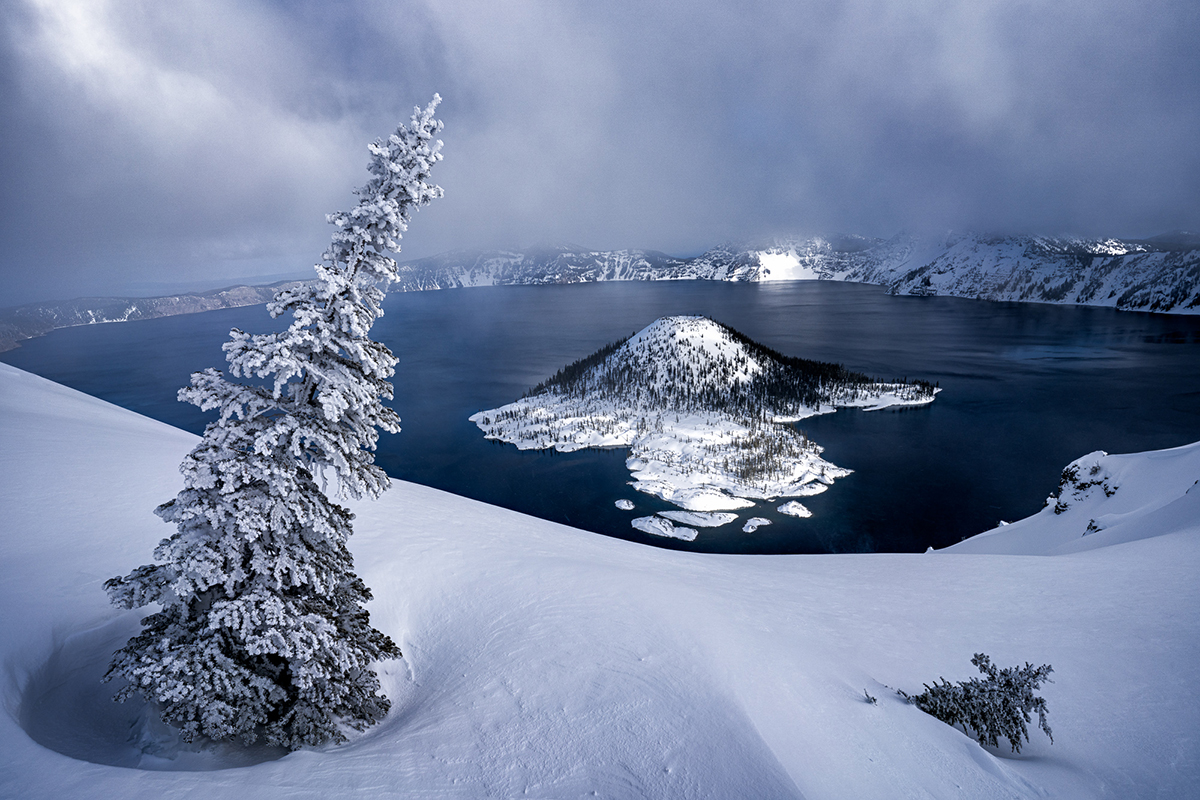Remote Access
With his Tamron 17-28mm and 28-75mm Di III RXD lenses, Austin Jackson captures landscapes that most people don’t get to see.
More Photo Tips | Video Gallery | Photo Gallery | Enewsletter sign-up
By Jenn Gidman
Images by Austin James Jackson
Every morning, Austin Jackson wakes up stoked. That’s because there’s always a new adventure waiting for him, whether he’s doing a backcountry ski run, hiking in the Pacific Northwest, or running a workshop, where he mentors students on how to become better landscape photographers. When it comes to scouting out locations for his shoots, the further away from civilization, the better. “I love discovering far-flung places that not everyone can easily access, even if it takes me days to make my way there,” he says. “That way, people who normally wouldn’t be able to see those places themselves still have the opportunity to do so through my photos.”
Because Austin is often heading deep into the hinterlands, he needs to travel light, which makes his Sony full-frame mirrorless camera, along with his Tamron 17-28mm F/2.8 Di III RXD and 28-75mm F/2.8 Di III RXD lenses, invaluable for the work he creates. “Not only are these two lenses compact and lightweight, but they don’t skimp on quality—they’re both incredibly sharp,” he says. “They helped me take a lot of weight off my back, which in turn allowed me to head out to a bunch of places I wouldn’t have been able to otherwise.”
Read on for the backstory on some of Austin’s recent landscape photos, which have taken him from the icy terrains of the Great White North to the stunning slot canyons of Utah.
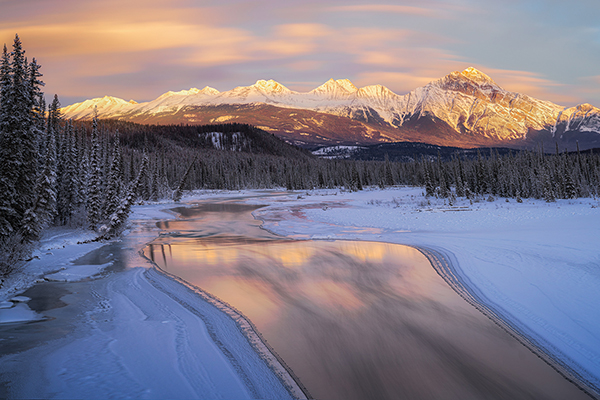
28-75mm (53mm), F/8, 30 sec., ISO 100
Click image to view larger
I was driving around a rural part of Canada and stopped to take this photo from a bridge. It wasn’t supposed to be cloudy that day, but surprise—there were clouds. Unfortunately, they weren’t interesting clouds that would’ve dramatically transformed my photo, so I shot at a longer exposure to blur them a bit and give them just a little color. That long 30-second exposure also had the effect of smoothing out the clouds’ reflection in the river into streaks, because I didn’t like the way the river looked with the chunkier cloud reflections. It was distracting.
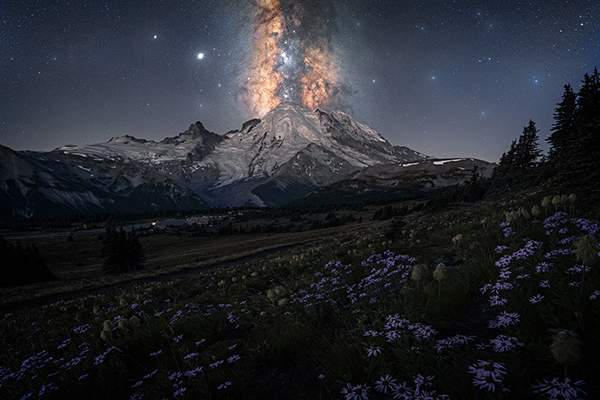
17-28mm (17mm), F/11, 6 sec., ISO 400
Click image to view larger
I was on the lookout for colorful flowers to shoot on a landscape, with Mount Rainier as the backdrop. I came across these flowers right before sunset. They were a whitish-purple color, which I knew would pop really well in a nighttime image, especially after I got through with the post-processing. So I posted up and waited until around 2am to take this photo with the Milky Way looking like it was emerging out of the mountain. I took this at 17mm, because I wanted as wide an image as possible to show off all of the flowers.
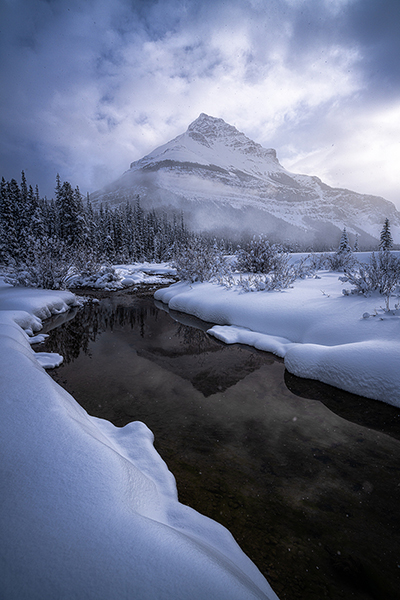
17-28mm (20mm), F/8, 1/640th sec., ISO 100
Click image to view larger
I took this image early in the winter season, in a remote part of Canada right off the highway.The water in this scene served as a natural leading line heading back toward the mountain, which also reflected nicely in the water. The sun was also trying its best to peek through the clouds, and it was snowing. I loved the effect of the snowflake spots showing up in the image, which gave it a more wintry feeling.
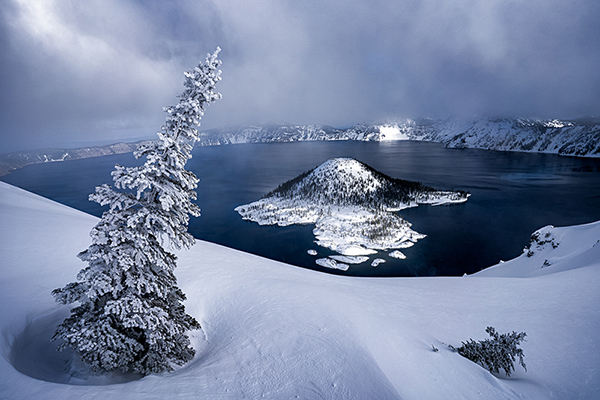
17-28mm (17mm), F/14, 1/160th sec., ISO 100
Click image to view larger
This is one of the best spots in Oregon’s Crater Lake National Park from a photographic standpoint, because of the way that little island sits in the middle of the water. Normally you can drive here, but during the winter, most of the main roads are closed. So on this particular day, we skied and snowshoed there, which was a 16-mile round trip, and camped there overnight. I was hoping to get some good light the next day, but it was cloudy for most of the morning and early afternoon. Finally, toward the later afternoon, a bit of sunlight started hitting the lake. Along with those clouds, it made for a moody scene.

28-75mm (52mm), F/11, 1.6 sec., ISO 50
Click image to view larger
When I stumbled onto this waterfall during a hike, I didn't like the lighting or composition I was getting with the wider lens. There were too many plants surrounding it, and I knew a wide-angle shot wouldn’t turn out that compelling. So I used the 28-75mm lens to zoom in and isolate the water on its own, without all of those extraneous elements. I liked the way the water hit all of the little rocks and how much depth the image has, which I like to enhance by dodging and burning. When I take waterfall photos, I also usually make sure to reduce the saturation of the blues in the water.

17-28mm (20mm), F/13, 1 sec., ISO 100
We had to wade through waist-deep water to get to this section of these Utah slot canyons. The water was totally black, because it had been sitting down there for who knows how long. It was fun to scramble up and frame the shot, with these crazy stripes running throughout; I was pretty high off the ground. The stripes in this portion of the canyon were very well-preserved. As you went lower, they tended to become more faded, because when the flash floods come through on the lower levels, they wash over the rocks and wash out those stripes.

17-28mm (17mm), F/2.8, 30 sec., ISO 3200
Click image to view larger
I was out in Arizona for about a week, and there were simply no clouds, so I was racking my brain for ideas on the different types of photos I could do. Because we were facing the north, I decided to create a star trail. I walked around during the day to find some cactus to frame my shot. This location was perfect, with cactus everywhere. I had to be careful when I went back in the dark, however, because the cactus would stick into me if I brushed up against it while I was walking. A 30-second exposure pointed at the North Star helped me create this effect.

17-28mm (17mm), F/11, 1/20th sec., ISO 50
Click image to view larger
This image was taken during a weeklong backpacking trip in Washington’s Olympic Mountains. I’d discovered this glacial lake while browsing Google Earth, so we decided to head up there. We didn’t have any idea of how frozen it would still be in August. I also didn’t know there would be wildflowers in bloom, so that was another stroke of luck. We arrived at this area right at sunrise, so I was able to capture a photo of the light hitting that one section of the mountain range and the flowers, which made for a lovely contrast.
To join a workshop with Austin Jackson, visit www.austinjamesjackson.com/workshops.
More Photo Tips | Watch Videos | Learn More About Tamron Lenses | Photo Gallery
